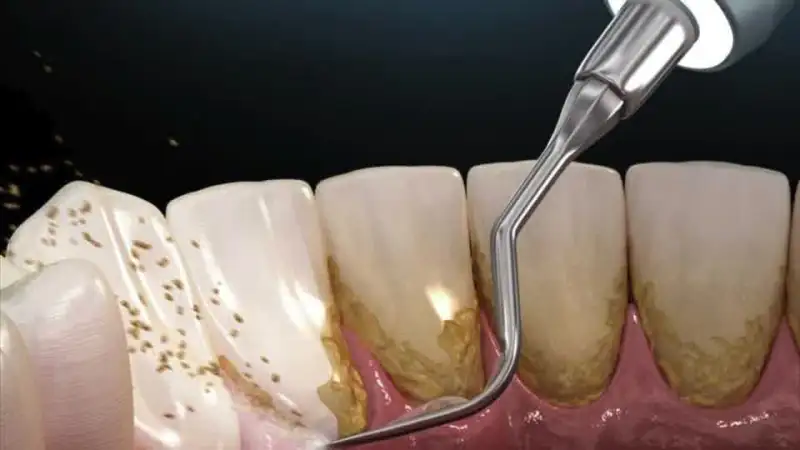Are you looking for an effective dental plaque remedy? You’re not alone. A sticky film of bacteria that builds up on teeth, known as dental plaque, is the primary cause of tooth decay and gum disease. Learn about dental plaque, its causes, and what remedies you can implement to improve your dental hygiene.
Understanding Dental Plaque and Its Impact on Oral Health
The dental plaque that forms a sticky film on your teeth is not just an unpleasant sight but also poses serious threats to oral health. This persistent biofilm becomes a breeding ground for bacteria thriving on leftover food particles in the mouth.
The Role of Biofilms in Tartar Formation
Biofilms are microorganisms living together as communities, adhering to each other and surfaces they come into contact with. These structures form the primary component of what we know as dental plaque or tartar. About 95% of bacteria existing in nature reside within these intricate microbial ecosystems – highlighting their importance beyond just oral health. In our mouths, biofilms can develop anywhere – from teeth and gums to tongues, wherever there’s space for growth. Consuming foods rich in sugars and starches, like fruits or bread, nourishes specific bacteria within these oral biofilm communities. This leads to rapid bacterial proliferation, subsequently increasing the volume of this sticky film enveloping our teeth – often called plaque build-up. If not removed through regular brushing and flossing, over time, this soft layer hardens into tartar. – significantly more challenging to remove than its predecessor due to its rough surface providing an ideal environment for further bacterial growth, potentially leading toward tooth decay or gum disease if left unchecked. An excessive presence of biofilms contributes to unsightly aesthetics. It may result in lousy breath due mainly to the production of foul-smelling compounds such as hydrogen sulfide during the metabolic process inside the mouth environment. Furthermore, inflammation often accompanies unchecked bacterial activity, possibly even receding gums eventually down the line unless proper hygiene practices are maintained regularly at home.
Natural Remedies for Reducing Biofilms
Regarding preventing tartar buildup, we’re not limited to commercial dental products. Nature has provided various substances that can effectively disrupt biofilm production – the root cause of plaque and tartar. Let’s delve into two key players: xylitol and specific herbs known for their oral health benefits.
The Power of Xylitol
Xylitol isn’t your typical sweetener. This natural sugar alcohol stands out due to its potent antibiofilm properties. Its structure is such that it inhibits bacteria from adhering to teeth surfaces, thereby curtailing plaque formation.
Incorporating xylitol gum into your daily routine could help break down these bacterial colonies before they harden into stubborn tartar.

Herbs for Oral Health
Moving on from xylitol, let’s talk about herbs – nature’s pharmacy brimming with remedies that can improve our dental health by tackling biofilms head-on. Rosemary doesn’t just spice up your dishes; this herb may also spice up your oral hygiene regimen. Rosemary, packed with anti-inflammatory and antimicrobial compounds, helps combat bacteria contributing to biofilm formation in the mouth. Curcumin (turmeric) and cinnamon have also been studied extensively for their powerful anti-biofilm activities against many harmful bacteria in the mouth. These plant-based wonders work synergistically, not only reducing microbial growth but also promoting overall oral health. So there you have it, some natural tools within reach to help maintain better dental hygiene without solely relying on over-the-counter solutions.
The #1 Remedy for Dental Plaque
A critical factor influencing our oral health is the pH balance in our mouths. Combining baking soda and hydrogen peroxide can help to maintain a healthy pH balance in the mouth, thereby preventing tartar buildup.
Baking Soda’s Role in Preventing Tartar Buildup
As an alkaline substance, baking soda is crucial in maintaining oral health. It elevates the pH level inside your mouth, making it difficult for bacteria that can lead to plaque buildup to thrive. In addition to altering the oral environment, baking soda disrupts biofilms – bacteria colonies encased within a protective layer resistant to ordinary brushing or rinsing with water alone. As shown by research, baking soda can penetrate these layers and break down their structure, preventing potential damage to teeth and gums.
The Benefits of Hydrogen Peroxide
Hydrogen peroxide forms another critical part of this potent home remedy against tartar buildup due to its antimicrobial properties. It effectively kills microbes on tooth surfaces before they have a chance to form biofilm structures. Beyond its antibacterial action, hydrogen peroxide directly inhibits biofilm development, too. As confirmed by scientific studies, this two-pronged approach – eliminating bacteria while preventing new bacterial communities from forming – provides significant protection against dental plaque.
Mixing Baking Soda Solution With Hydrogen Peroxide
To create this powerful anti-tartar solution at home, you need equal parts baking soda and 1% – 3% concentration hydrogen peroxide mixed into a paste-like consistency. Use it like regular toothpaste; apply it onto your toothbrush, then brush thoroughly but gently over all areas where tartar tends to accumulate: between teeth, along gum lines, etc. Once you’re done brushing, make sure to rinse thoroughly with water. Keep going until there’s no residue left.
Dietary Changes to Promote Oral Health
It’s a little-known fact that our diet can profoundly impact oral health and even influence the formation of dental plaque. Let’s delve deeper into how modifying our diet can help maintain optimal oral health.
Sugar: The Tooth’s Enemy
You might not be surprised to hear that sugar is one of the main contributors to dental plaque. When bacteria in your mouth get their microscopic hands-on sugars, they produce acids that gnaw away at your tooth enamel and encourage plaque buildup. Reducing sugar could significantly lower your risk of developing dental problems. A study published by The Journal of Dental Research found clear evidence linking high-sugar diets with an increased likelihood of cavities.
Eating Your Way To Better Oral Health
Moving beyond sugar, a proper diet full of vitamins, minerals, and antioxidants is also crucial for maintaining good oral health. Vitamins A, C & D are particularly beneficial for gum health, while calcium strengthens teeth. On top of this list are leafy greens, too. Packed with magnesium (known for its role in bone density), these foods strengthen teeth, according to the National Institutes Of Health (NIH).
The Natural Toothbrushes: Crunchy Vegetables
Did you know certain foods clean your teeth as you munch them? This includes crunchy vegetables like carrots, which stimulate saliva production, helping rinse away food particles along with any lingering bacteria.
Including such items in daily meals may prove advantageous for achieving better hygiene levels. So, next time you reach for a snack, consider grabbing something crunchier than usual.

Dental Plaque Home Remedies
Addressing dental plaque is essential for maintaining good oral health and preventing issues like bad breath. You can try various home remedies to help reduce plaque buildup on your teeth and gums. Incorporating practices like regular brushing and flossing, using antibacterial mouthwash, and consuming foods that promote oral health can all contribute to managing dental plaque. By adopting these home remedies for bad breath, you’re combating the causes of bad breath and taking proactive steps to enhance your oral hygiene.
Conclusion
Understanding dental plaque is the first step towards achieving a healthier smile. The role of biofilms in tartar formation should not be underestimated, as they are a significant component of dental plaque and can lead to serious oral health issues if left unchecked. Natural remedies such as xylitol and herbs like rosemary, clove, thyme, oregano oil, garlic, curcumin (found in turmeric), and cinnamon effectively reduce biofilm production. Baking soda mixed with hydrogen peroxide emerges as an impressive dental plaque remedy due to its ability to maintain oral pH balance and inhibit biofilm development. Dietary changes also play a crucial part in promoting oral health by creating an unfavorable environment for the growth of harmful bacteria.







